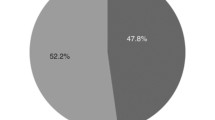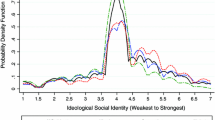Abstract
The notion that ideological perceptions in the mass public are shaped to some extent by elites and political candidates is widespread in the public opinion literature. However, there has been a lack of empirical research directly demonstrating the links between elites and the masses whose thinking they supposedly cue and structure. This paper attempts to show, through magnitude scale data collected over time in the 1980 campaign, the significant impact of political candidates in altering ideological perceptions of political stimuli. The chief “carrier” of ideology in 1980 is shown to be Ronald Reagan, whose strong issue stands and ideological label influenced perceptions of specific issues' ideological content. The findings are discussed in terms of both measurement problems in the ideology literature and more general theories of elite and environmental influences on mass political thought.
Similar content being viewed by others
References
Abramson, Paul R. (1981). “Comment on Smith.”American Political Science Review 75: 146–149.
Abramson, Paul R. (1982).Political Attitudes in America. New York: W. H. Freeman and Company.
Asher, Herbert (1976).Presidential Elections and American Politics. Homewood, Ill.: Dorsey Press.
Campbell, Angus, P. Converse, W. Miller, and D. Stokes (1960).The American Voter. New York: John Wiley.
Converse, Philip E. (1975). “Public Opinion and Voting Behavior.” In Fred Greenstein and Nelson Polsby (eds.),Handbook of Political Science (Vol. 4). Reading, Mass.: Addison-Wesley.
Duncan, O. D. (1969). “Some Linear Models for Two-Wave, Two-Variable Panel Analysis.”Psychological Bulletin 72: 177–182.
Field, J. O., and R. E. Anderson (1969). “Ideology in the Public's Conception of the 1964 Election.”Public Opinion Quarterly 33: 380–398.
Hagner, Paul R., and John C. Pierce (1982). “Correlative Characteristics of Levels of Conceptualization in the American Public, 1956–76.”Journal of Politics 44: 779–809.
Heise, David R. (1969). “Casual Inference from Panel Data.” In E. Borgatta (ed.),Sociological Methodology. San Francisco: Jossey-Bass.
Klingemann, Hans D., and William E. Wright (1973). “Modes of Conceptualization and the Organization of Issue Beliefs in Mass Publics.” Paper presented at the World Congress of the International Political Association, Montreal, Canada.
Lodge, Milton (1981).Magnitude Scaling: Quantitative Measurement of Opinions. Sage University Paper Series on Quantitative Applications in the Social Sciences, Series No. 07-025. Beverly Hills: Sage Publications.
Lodge, Milton, and Bernard Tursky (1981). “On the Magnitude Scaling of Political Opinion in Survey Research.”American Journal of Political Science 25: 376–419.
Miller, Arthur, and Warren E. Miller (1976). “Ideology in the 1972 Election: Myth or Reality — A Rejoinder.”American Political Science Review 70: 832–849.
Nie, Norman H., and K. Anderson (1974). “Mass Belief Systems Revisited: Political Change and Attitude Structure.”Journal of Politics 36: 540–591.
Nie, Norman H., Sidney Verba, and John Petrocik (1976).The Changing American Voter. Cambridge: Harvard University Press.
Nie, Norman H., Sidney Verba, and John Petrocik (1981). “Reply.”American Political Science Review 75: 149–152.
Niemi, Richard G., and Herbert F. Weisberg (1976).Controversies in American Voting Behavior. San Francisco: W. H. Freeman.
Petrocik, John (1980). “Contextual Sources of Voting Behavior.” In J. Pierce and J. Sullivan (eds.),The Electorate Reconsidered. Beverly Hills: Sage Publications.
Pierce, John C., Kathleen M. Beatty, and Paul R. Hagner (1982).The Dynamics of American Public Opinion. Glenview, Ill.: Scott, Foresman.
Smith, Eric R.A.N. (1980). “False Measures of Ideological Sophistication.”American Political Science Review 74: 685–696.
Author information
Authors and Affiliations
Rights and permissions
About this article
Cite this article
Finkel, S., Norpoth, H. Candidates and issues in the 1980 campaign: The ideological connection. Polit Behav 6, 61–77 (1984). https://doi.org/10.1007/BF00988229
Issue Date:
DOI: https://doi.org/10.1007/BF00988229




